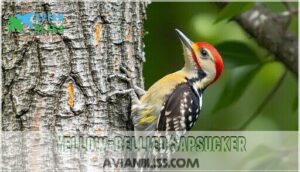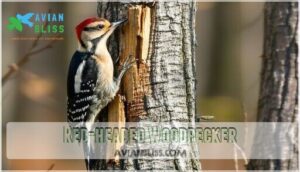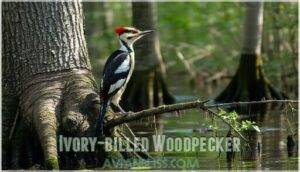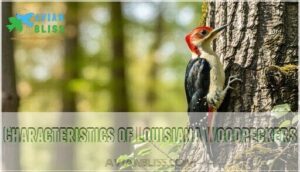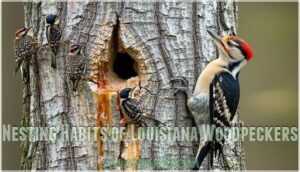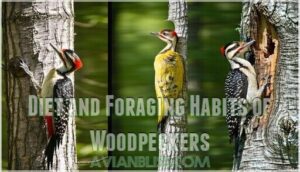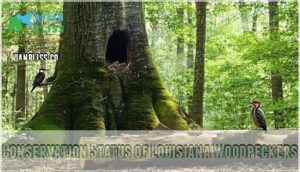This site is supported by our readers. We may earn a commission, at no cost to you, if you purchase through links.
 You’ll find nine distinct woodpeckers of Louisiana, from the tiny 6-inch Downy Woodpecker to the massive 19-inch Pileated Woodpecker that sounds like nature’s jackhammer.
You’ll find nine distinct woodpeckers of Louisiana, from the tiny 6-inch Downy Woodpecker to the massive 19-inch Pileated Woodpecker that sounds like nature’s jackhammer.
These remarkable birds have adapted to everything from cypress swamps to urban parks, making them some of the most accessible wildlife you can observe.
Each species brings unique behaviors and habitat preferences to Louisiana’s diverse forests and woodlands.
The Red-cockaded Woodpecker stands out as critically endangered, while others like the Red-bellied Woodpecker thrive in backyard settings.
Some species display fascinating cooperative breeding systems and specialized feeding techniques that set them apart from typical backyard birds, showcasing their unique characteristics in Louisiana’s diverse forests.
Table Of Contents
- Key Takeaways
- Types of Woodpeckers in Louisiana
- Characteristics of Louisiana Woodpeckers
- Size and Weight of Louisiana Woodpeckers
- Nesting Habits of Louisiana Woodpeckers
- Diet and Foraging Habits of Woodpeckers
- Abundance and Rarity of Louisiana Woodpeckers
- Attracting Louisiana Woodpeckers to Your Yard
- Woodpecker Identification and Calls
- Conservation Status of Louisiana Woodpeckers
- Fun Facts About Louisiana Woodpeckers
- Frequently Asked Questions (FAQs)
- What is the rarest woodpecker in Louisiana?
- How can you tell a sapsucker from a woodpecker?
- What does it mean when woodpeckers pecking at your house?
- Is it good to have woodpeckers in your yard?
- Are there woodpeckers in Louisiana?
- Are ivory-billed woodpeckers found in Louisiana?
- Where do red cockaded woodpeckers live?
- What is The Woodpeckers?
- Are woodpeckers good to have in your yard?
- Are woodpeckers protected in Louisiana?
- Conclusion
Key Takeaways
- You’ll find nine distinct woodpecker species in Louisiana, ranging from the tiny 6-inch Downy Woodpecker to the massive 19-inch Pileated Woodpecker, each adapted to different habitats from cypress swamps to urban parks.
- The Red-cockaded Woodpecker stands out as Louisiana’s rarest and most endangered species, requiring mature pine forests and using a unique cooperative breeding system where family groups help raise young together.
- You can attract woodpeckers to your yard by providing suet feeders, leaving dead trees standing, and creating water sources, as these birds need high-fat foods and prefer natural nesting cavities in dead wood.
- Each species has distinctive identification features and calls, with males typically displaying red patches that females lack, and unique behaviors like the Red-headed Woodpecker’s aerial insect-catching abilities and the Yellow-bellied Sapsucker‘s methodical sap well drilling.
Types of Woodpeckers in Louisiana
You’ll find nine distinct woodpecker species calling Louisiana home, each with unique characteristics and behaviors that make them fascinating to observe.
Louisiana’s forests echo with the rhythmic drumming of nine remarkable woodpecker species, each perfectly adapted to their unique ecological niche.
From the massive Pileated Woodpecker to the tiny Downy Woodpecker, these birds showcase remarkable diversity in size, feeding habits, and habitat preferences across the state’s varied landscapes.
Northern Flicker
Among Louisiana’s woodpecker species, the Northern Flicker stands out with its ground foraging behavior and distinctive yellow underwings.
Unlike other Louisiana woodpeckers, flickers prefer hunting ants on the ground rather than drilling into trees.
These fascinating birds showcase unique characteristics:
- Migration Patterns: Northern populations migrate south, while Louisiana residents stay year-round
- Tongue Length: Extends up to 2 inches beyond their bill for capturing insects
- Flicker Hybrids: Occasionally interbreed with Red-shafted Flickers in western regions.
Despite habitat loss concerns, these adaptable Louisiana birds continue thriving in open woodlands and suburban areas.
Yellow-bellied Sapsucker
The Yellow-bellied Sapsucker creates distinctive sapsucker sap wells in neat rows on tree bark throughout Louisiana’s forests.
Their sapsucker migration patterns bring them to Louisiana’s range during winter months, making woodpecker identification easier for bird enthusiasts.
Key identification features include:
- Red forehead and throat patch
- White wing stripe visible in flight
- Yellowish belly coloring
- Nasal mewing calls
Their habitat preferences include mature deciduous and mixed forests where they can establish their feeding territories among Louisiana birds.
Red-cockaded Woodpecker
For those seeking Louisiana woodpeckers, the Red-cockaded Woodpecker stands as the state’s most endangered species.
This cooperative breeding specialist excavates cavities in living pine trees, requiring cavity tree management and habitat fragmentation solutions.
Population recovery plans focus on genetic diversity concerns while protecting remaining clusters.
Woodpecker conservation efforts emphasize prescribed burns and longleaf pine restoration for sustainable woodpecker habitat protection.
They thrive in mature pine forests maintained by fire.
Red-headed Woodpecker
The Red-headed Woodpecker stands out among Louisiana woodpeckers with its striking crimson head that makes bird identification straightforward. Unlike other woodpecker species, both males and females sport identical bright red plumage from bill to neck.
This Redheaded Woodpecker excels at aerial foraging, catching insects mid-flight with impressive acrobatics. Their omnivorous diet includes nuts, seeds, fruits, and occasionally small reptiles. These birds practice nest reuse, returning to the same cavity for multiple seasons.
Unfortunately, this species faces significant population decline due to habitat loss and competition from European Starlings. Conservation efforts focus on preserving their preferred woodpecker habitat of open woodlands and dead trees.
Key features of Red-headed Woodpeckers:
- Solid crimson head with white chest and black back
- Expert aerial hunters catching insects on the wing
- Store food in tree crevices for winter months
- Prefer open woodlands with scattered dead trees
- Face ongoing population challenges requiring habitat protection
Pileated Woodpecker
You’ll spot Louisiana’s pileated woodpecker by its striking red crest and crow-sized frame.
These magnificent birds prefer mature forests with dead trees for cavity nesting. Their loud drumming communication echoes through woodlands as they search for carpenter ants.
Forest management practices help maintain their woodpecker habitat, though habitat loss threatens populations.
Backyard encounters occur near wooded areas where these impressive Louisiana woodpeckers showcase their unique woodpecker behavior and specialized woodpecker diet.
Red-bellied Woodpecker
Louisiana’s most common woodpecker species makes its presence known with distinctive chuck-chuck-chuck calls echoing through forests and suburban areas.
The Red Belly woodpecker’s striking appearance catches birders’ attention immediately.
Here’s what makes this Redbellied Woodpecker special:
- Males sport bright red plumage from bill to neck, while females show red only on their nape
- Their Woodpecker Diet includes spiders, beetles, acorns, and berries stored in Tree Drilling cavities
- Forest Habitat preferences include wooded suburbs, parks, and mature forests throughout Louisiana
- These Louisiana woodpeckers dominate feeders, often chasing away smaller birds with their bold behavior
Downy Woodpecker
You’ll spot the Downy Woodpecker by its petite size and distinctive woodpecker feathers.
This smallest North American species thrives in Louisiana’s forest habitat, from backyards to parks.
Their woodpecker behavior includes acrobatic foraging for insects, especially wood-boring beetles.
These Louisiana woodpeckers don’t follow bird migration patterns, staying year-round.
When birdwatching in Louisiana, listen for their quiet "pik" call.
Woodpeckers like the Downy Woodpecker often engage in acorn storage methods to survive, although their primary food source is insects.
Open forests, parks, backyards
Wood-boring beetles are a favorite
Hairy Woodpecker
While the Downy Woodpecker charms with its small size, the Hairy Woodpecker commands attention as its larger cousin.
This black-and-white bird masters tree climbing with powerful claws, searching mature forests for beetle larvae. Males sport a distinctive red patch that females lack.
- Sharp "peek" calls echo through Louisiana’s woodlands, announcing their presence
- Chisel-like beaks expertly extract insects from deep bark crevices
- Year-round residents provide consistent birdwatching opportunities across the state
These woodpeckers of Louisiana prefer mature deciduous and coniferous forests, making them excellent subjects for birdwatching in Louisiana adventures.
Ivory-billed Woodpecker
Once considered North America’s largest woodpecker, the Ivory-billed Woodpecker now holds Extinction Status as "possibly extinct."
Habitat Loss from logging destroyed Louisiana’s bottomland forests where these magnificent birds thrived.
The last confirmed sighting occurred in 1944, making this the rarest of woodpecker species in Louisiana.
Conservation Efforts continue despite challenges.
Recent Woodpecker Biology research suggests possible survival in Louisiana woodlands, though evidence remains controversial.
You might confuse surviving birds with Pileated Woodpeckers, but Ivory-bills displayed distinctive white wing patches and larger size.
Unlike the Red-Cockaded Woodpecker, which adapts to different habitats, this Rare Species required vast old-growth forests.
The Ivorybilled Woodpecker represents both loss and hope for woodpeckers of Louisiana.
Researchers study the ivory billed woodpecker to understand its decline.
| Keyword | Information |
|---|---|
| Extinct | Often considered extinct |
| Last sighting | 1944, Louisiana |
| Reintroduction | Facing challenges |
| Habitat loss | Major threat |
| Similar species | Pileated woodpecker often mistaken |
Characteristics of Louisiana Woodpeckers
With their specialized anatomy, Louisiana’s woodpeckers showcase remarkable adaptations for their tree-dwelling lifestyle.
These birds demonstrate incredible woodpecker diversity across Louisiana’s varied ecosystems, from coastal marshes to upland forests.
Beak Shapes vary dramatically among species—some feature chisel-like bills for excavating, while others have longer, curved beaks for probing. Feather Patterns create stunning visual displays, with most species sporting black, white, and red combinations that provide camouflage and species recognition.
Head Colors distinguish males from females in most species, with males typically displaying bright red patches. Tail Feathers serve as props, helping them maintain balance while climbing vertical surfaces.
Here are four key woodpecker characteristics you’ll notice:
- Zygodactyl feet with two toes forward, two backward for superior gripping
- Reinforced skull structure that absorbs drilling impact
- Specialized tongue extending far beyond the beak for extracting insects
- Stiff tail feathers that act as a third leg for support.
These woodpecker characteristics reflect millions of years of evolution, perfectly suiting each species to Louisiana’s diverse woodpecker habitats. Understanding local bird species is essential for appreciating the unique adaptations of woodpeckers in the region.
Size and Weight of Louisiana Woodpeckers
You’ll find Louisiana’s woodpeckers come in four distinct size categories, from the tiny Downy Woodpecker at just 0.8 ounces to the massive Pileated Woodpecker weighing up to 10.5 ounces.
Understanding these size differences helps you identify which species you’re watching and explains their different behaviors and habitat preferences.
Largest Woodpecker in Louisiana
The pileated woodpecker stands as Louisiana’s largest woodpecker species, measuring 17.5 inches and weighing 10.5 ounces.
You’ll spot this crow-sized bird by its striking red crest and black-and-white plumage.
Size comparison reveals it’s over 13 times heavier than Louisiana’s smallest woodpecker.
These magnificent birds prefer mature forests for their habitat needs, where their foraging habits focus on carpenter ants and beetle larvae through their ecological role as primary excavators.
Smallest Woodpecker in Louisiana
When searching for Louisiana’s tiniest woodpecker species, you’ll discover the Downy Woodpecker weighing just 0.8 ounces and measuring 6.1 inches.
This acrobatic bird frequents backyard feeders and urban woodlands, often foraging alongside chickadees.
Its petite size and black-and-white plumage make it easily distinguishable from other Louisiana woodpeckers through simple size comparison techniques.
Medium-Sized Woodpeckers
Louisiana’s medium-sized woodpeckers include the red-bellied, red-headed, and hairy woodpeckers.
These woodpecker species average 8.3–9.4 inches long and weigh 2.4–2.6 ounces.
You’ll spot plumage variation between males and females, with males displaying distinctive red patches.
Their habitat preference includes mature forests and suburban areas.
Foraging differences show varied techniques—red-bellied woodpeckers dominate feeders while red-headed species catch insects mid-air.
Conservation needs focus on maintaining dead trees for breeding behavior and nesting sites across Louisiana’s diverse woodpecker habitats.
Small-Sized Woodpeckers
Three small-sized woodpeckers call Louisiana home.
The Downy Woodpecker weighs just 0.8 ounces and measures 6.1 inches, making it Louisiana’s tiniest woodpecker species.
You’ll spot these acrobatic birds easily at backyard feeders, where their Downy Identification becomes simple through their short bills and black-and-white plumage.
Yellow-bellied Sapsuckers and Red-cockaded Woodpeckers complete this petite trio.
Nesting Habits of Louisiana Woodpeckers
Louisiana’s nine woodpecker species showcase fascinating nesting behaviors that vary substantially across different species.
You’ll discover that most woodpeckers excavate fresh cavities each year in dead trees, though the Red-cockaded Woodpecker stands out by drilling into living pine trees and using a unique cooperative breeding system.
Excavating Nesting Cavities
When you watch a woodpecker excavate nesting cavities, you’re witnessing nature’s master carpenter at work.
These birds invest weeks chiseling perfect homes, carefully selecting wood preference and cavity size for their families. Excavation time varies by species, but most complete their woodpecker cavities within 2-3 weeks using powerful beaks and zygodactyl feet.
- Cavity entrance holes measure 1.5-3 inches depending on species size
- Nesting competition drives woodpeckers to choose ideal excavation sites in dead trees
- Cavity reuse occurs rarely, as most woodpecker nesting habits favor fresh excavations annually
Nesting Materials and Structure
Louisiana’s woodpeckers craft their homes with precision, creating woodpecker cavities that serve as nurseries.
These birds prefer specific cavity size dimensions and nesting depth requirements. The entrance hole shape varies by species, while wood chip bedding cushions eggs.
Material preference typically favors dead trees, though some species choose live wood for their woodpecker nests.
| Nest Feature | Specifications |
|---|---|
| Cavity Depth | 6-20 inches deep |
| Entrance Size | 1.25-4 inches wide |
| Wood Chips | Natural bedding layer |
Cooperative Breeding System
Red-cockaded woodpeckers showcase Louisiana’s most complex woodpecker cooperative breeding system.
You’ll find woodpecker alpha pair leading groups of two to six birds, with woodpecker nonbreeding helpers – usually woodpecker siblings from previous years.
These helpers boost breeding success through territory defense and chick care.
Kin selection drives this teamwork, as helper benefits include increased family survival.
Group size matters for woodpecker breeding habits success.
Diet and Foraging Habits of Woodpeckers
You’ll find that woodpeckers in Louisiana have developed three distinct feeding strategies based on their preferred food sources.
Each species has specialized techniques for finding insects, sap, or ground-dwelling prey that match their unique physical adaptations.
Typical Woodpeckers
Most common woodpeckers in Louisiana are typical woodpeckers that hitch along tree trunks and branches, searching for their next meal.
Their specialized woodpecker anatomy includes strong beaks and long tongues perfect for bark foraging and insect consumption.
Here’s how these birdwatching Louisiana favorites find food:
- Peeling bark to uncover beetle larvae and ant colonies
- Drilling holes in dead wood to reach wood-boring insects
- Probing crevices with their sticky tongues for hidden bugs
- Storing food in tree bark for winter survival
Their habitat preference for mature forests with dead trees provides endless foraging opportunities year-round.
Flickers and Sapsuckers
Flicker foraging involves ground-based ant hunting, while Sapsucker sapwells provide tree sap and trapped insects.
Northern Flicker uses its sticky tongue for ants aplenty, contrasting with Yellow-bellied Sapsucker’s methodical drilling technique.
This diet comparison reveals fascinating habitat overlap in Louisiana distribution.
Birdwatching Louisiana enthusiasts notice distinct calls—Flicker’s "wicka wicka" versus Sapsucker’s "churring"—helping identify these woodpecker flickers and woodpecker sapsuckers.
Ground foraging
Tree drilling
Wicka" vs. "Churr"
Red-headed Woodpeckers
Unlike other Louisiana bird species, Red-headed Woodpeckers showcase remarkable Aerial Foraging skills, catching insects mid-flight with precision.
These woodpecker species maintain an Omnivorous Diet, consuming insects, nuts, seeds, berries, and occasionally eggs.
Their distinctive Plumage Variations feature brilliant crimson heads in both sexes.
Unfortunately, Population Decline threatens these Louisiana residents due to habitat loss.
They practice Nest Reuse, returning to familiar cavities in woodpecker habitats in Louisiana, making them unique among RedHeaded Woodpecker populations.
Yellow-bellied Sapsuckers
Yellow-bellied Sapsuckers drill precise sap wells in neat rows across tree bark, creating nature’s sweetest buffet. These woodpecker species migrate through Louisiana’s forests, showing plumage variations between males and females.
Sapsucker migration brings these unique birds to Louisiana habitat seasonally. Despite conservation challenges, they’re essential to woodpecker habitats in Louisiana. Yellowbellied Sapsucker feeding doesn’t permanently harm trees.
- Watch for their methodical drilling patterns creating geometric sap well designs
- Listen for their distinctive cat-like mewing calls echoing through Louisiana forests
- Notice how they return to the same productive trees year after year
- Observe their patient waiting as sap flows into their carefully crafted wells
- Marvel at their ability to locate the sweetest sap-producing tree species
Abundance and Rarity of Louisiana Woodpeckers
You’ll find that Louisiana’s woodpecker species vary dramatically in abundance, with the Red-bellied Woodpecker being the most common resident.
The Ivory-billed Woodpecker remains the rarest and most elusive, while the Red-headed and Red-cockaded Woodpeckers represent the least numerous species.
The Red-headed and Red-cockaded Woodpeckers facing significant population challenges that make every sighting special for birdwatchers.
Most Common Woodpecker in Louisiana
You’ll find the Red-bellied Woodpecker reigning as Louisiana’s most abundant species.
This adaptable bird thrives across diverse habitats, from dense forests to suburban backyards.
Its Urban Adaptation skills and flexible Feeding Habits contribute to stable Population Trends.
Unlike specialized species facing Conservation Concerns, this redbellied woodpecker demonstrates remarkable Habitat Preference flexibility throughout Louisiana.
Least Numerous Woodpeckers
While the Red-bellied Woodpecker thrives throughout Louisiana, several species face significant challenges.
The Red-cockaded Woodpecker represents the state’s most endangered woodpecker species, with habitat loss devastating their population. Conservation strategies now focus on protecting remaining mature pine forests where these birds depend on trees over 60 years old.
Here are the key factors affecting these vulnerable species:
- Habitat Loss: Logging and development have eliminated essential nesting sites
- Population Monitoring: Scientists track breeding success through active colony counts
- Genetic Diversity: Small populations face increased risk of inbreeding
- Conservation Strategies: Artificial cavity installation helps support recovery efforts
The Ivory-billed Woodpecker remains Louisiana’s most mysterious species, with no confirmed sightings since 1944 despite ongoing searches.
Rarest Woodpecker in Louisiana
Among Louisiana’s woodpeckers, the red-cockaded woodpecker stands as the rarest species.
This endangered bird faces severe habitat loss as old-growth longleaf pine forests disappear.
Population estimates show only 340 active colonies remain, primarily in Kisatchie National Forest.
Conservation strategies focus on habitat restoration and artificial cavity creation.
Sighting verification proves challenging, making woodpecker conservation status monitoring essential for this declining endangered species.
Critically Endangered Species
Louisiana’s woodpecker endangered species face serious threats.
The redcockaded woodpecker sits on the endangered species list due to habitat loss and climate change.
Population decline continues despite conservation strategies aimed at protecting genetic diversity.
Louisiana’s remaining colonies depend on mature pine forests, but these ecosystems keep shrinking.
Woodpecker conservation status remains precarious without immediate action.
Picture these conservation challenges:
- Ancient pine forests disappearing under chainsaws and development
- Small, isolated colonies struggling to find mates and maintain genetic diversity
- Hurricane-damaged trees reducing available nesting sites
- Fire suppression creating dense understory that blocks flight paths
- Climate change pushing suitable habitat further north each decade
Attracting Louisiana Woodpeckers to Your Yard
You can transform your backyard into a woodpecker paradise by offering the right food, shelter, and nesting opportunities.
Setting up suet feeders, leaving dead trees standing, and creating a habitat that mimics their natural forest environment will attract these fascinating birds to your property year-round, making it a paradise.
Providing Food for Woodpeckers
Beyond bird watching, through Louisiana’s diverse landscapes, you’ll discover that woodpeckers have specific feeding preferences that make backyard attraction straightforward.
Suet feeders work best during winter months when insect availability drops. Seed choices like sunflower seeds attract multiple species year-round. Nut butters provide essential fats. Water sources complement woodpecker food sources effectively.
Understanding woodpecker feeding habits helps optimize woodpecker backyard bird feeders, especially when offering woodpecker fruits and seeds throughout Louisiana’s seasons. Many people find success using specialized suet feeders to attract woodpeckers.
Installing Woodpecker Feeders
Once you’ve chosen the right food, setting up effective backyard bird feeders requires strategic planning.
Proper feeder placement and maintenance will attract more woodpeckers to your Louisiana yard.
- Feeder Placement: Position suet feeders 5-6 feet high on tree trunks or poles, away from windows but visible from your house for easy observation of woodpecker feeding habits.
- Suet Recipes: Use high-fat suet mixed with peanuts, sunflower seeds, or dried fruit. Commercial suet blocks work well, but homemade versions let you control seed types. To find the best options, consider browsing various woodpecker suet feeders.
- Squirrel Deterrents: Install baffles below feeders or use caged feeders that allow woodpeckers access while blocking larger animals from stealing food.
- Feeder Maintenance: Clean bird feeders weekly with diluted bleach solution to prevent mold and disease, ensuring healthy woodpecker visits year-round.
Creating a Woodpecker Habitat
Creating woodpecker-friendly environments starts with deadwood management—leave standing dead trees that harbor insects woodpeckers love.
Plant native trees like oaks and pines to boost insect populations naturally.
Add water sources through shallow birdbaths or dripping fountains.
Create roosting shelters by maintaining tree cavities and dense shrubs.
These simple steps transform your Louisiana backyard into prime woodpecker habitats where backyard birds thrive alongside your bird feeders.
Providing Nesting Sites
Your backyard’s woodpecker appeal depends on offering suitable artificial nesting sites that match their natural preferences. Cavity size matters—entrance holes should be 1.25-2.5 inches depending on species.
Predator protection comes from proper placement and design. Consider browsing options for pre-made nesting boxes if building isn’t feasible.
- Use rough cedar or pine lumber for natural grip and durability
- Pack boxes with wood shavings to mimic woodpecker nesting cavities
- Mount 8-15 feet high on mature trees for habitat enhancement
- Verify woodpecker cavity depth of 8-12 inches for comfort
Installing a Bird Bath
A bird bath serves as your backyard’s invigorating oasis, attracting woodpeckers and other Louisiana bird species year-round. Position it in partial shade near trees for quick escape routes. Keep water depth at 1-2 inches for ideal bird habitats.
| Bath Placement | Material Choices |
|---|---|
| Near trees for cover | Concrete or ceramic |
| Partial shade location | Rough-textured surfaces |
| 3-4 feet high | Non-slip materials |
| Away from feeders | Natural stone basins |
| Visible from windows | Weather-resistant options |
Clean weekly during summer, winterizing baths with heaters when temperatures drop below freezing.
Woodpecker Identification and Calls
You’ll need to identify Louisiana’s nine woodpecker species by combining visual field marks with their distinctive calls and drumming patterns.
Each species has unique characteristics that separate males from females and juveniles, making proper identification easier when you know what to look for.
Visual Identification
Now you can identify Louisiana’s woodpeckers using specific field marks that make each species unique.
Look for plumage patterns like the red-headed woodpecker’s bright crimson head or the ladder-back design on red-cockaded juveniles. Bill shape and zygodactyl feet help distinguish species, while features like the red nape on males provide clear identification clues.
- Spot the telltale signs – Each species has distinctive markings that make identification exciting
- Notice the subtle differences – Juvenile plumage often differs from adults, adding identification challenges
- Appreciate nature’s artistry – The intricate patterns and colors showcase millions of years of evolution
- Feel the satisfaction – Successfully identifying a woodpecker species brings genuine accomplishment
Sound Recordings
Learning woodpecker sounds transforms your birdwatching experience from visual-only to multi-sensory identification.
Recording Equipment helps capture vocalizations for later Sonogram Analysis, revealing unique patterns in each species’ calls.
Regional Dialects exist among woodpecker populations, making sound recordings essential for accurate Call Identification across Louisiana’s diverse habitats.
- Drumming patterns reveal species identity faster than visual spotting
- Territorial calls echo through forests, announcing their presence before you see them
- Alarm notes alert you to hidden woodpeckers defending their territory
- Mating calls during breeding season provide the best identification opportunities
Field Marks for Male, Female, and Juvenile Birds
Plumage Differences tell the story—males sport red patches that females lack.
Juvenile Markings include bright red caps that fade with Seasonal Changes.
Regional Variations exist, but woodpecker male female differences remain consistent.
Study woodpecker field marks carefully for accurate woodpecker juvenile identification.
Hybrid Identification requires expert knowledge of woodpecker species accounts and woodpeckers of louisiana field guides.
Conservation Status of Louisiana Woodpeckers
Looking at the conservation status of Louisiana’s woodpeckers reveals both challenges and success stories you should know about.
While species like the Red-bellied Woodpecker remain common, others face significant threats from habitat loss and require ongoing protection efforts.
Threats to Woodpecker Populations
Louisiana’s woodpeckers face mounting challenges that threaten their survival. Habitat Loss from logging devastates nesting sites, while Climate Change intensifies hurricanes that destroy cavity trees.
Pesticide Use poisons food sources, and Invasive Species compete for resources. Human Disturbance fragments forests, creating isolated populations.
Louisiana’s diverse habitats also support many other species.
Key threats include:
- Forest destruction – Over 90% of longleaf pine habitat lost
- Storm damage – Hurricanes destroy critical nesting trees
- Disease outbreaks – Avian flu threatens wild populations
- Toxic chemicals – Pesticides reduce insect prey
- Invasive competitors – Non-native species disrupt ecosystems
Conservation Efforts
While habitat loss threatens Louisiana’s woodpeckers, dedicated conservation efforts are making a real difference.
Habitat Preservation through longleaf pine restoration has increased forest acreage from 3.4 to 5.2 million acres since 2010. Population Monitoring and artificial cavity installation help red-cockaded woodpeckers, whose numbers rose from under 10,000 to 15,000 birds.
| Conservation Strategy | Impact on Louisiana Woodpeckers |
|---|---|
| Reforestation Initiatives | Longleaf pine restoration supports habitat recovery |
| Prescribed Burning | Maintains open forest structure for nesting |
| Safe Harbor Programs | Incentivizes private landowner participation |
| Artificial Cavities | Provides nesting sites where natural cavities are scarce |
| Translocation Programs | Louisiana serves as donor state for population recovery |
Public Awareness campaigns and Legal Protections under the Endangered Species Act provide additional safeguards.
These coordinated woodpecker conservation efforts demonstrate how bird conservation in Louisiana can successfully restore Louisiana bird habitats through science-based management and community partnerships.
Protected Areas for Woodpeckers
Several key protected areas in Louisiana provide critical habitat preservation for woodpeckers, especially endangered species like the Red-cockaded Woodpecker.
These nesting sanctuaries support Louisiana bird conservation through active monitoring programs and reforestation projects.
- Kisatchie National Forest: Features conservation easements protecting old-growth pine habitats
- Atchafalaya National Wildlife Refuge: Maintains diverse bird habitats in Louisiana’s largest wetland
- Pearl River Wildlife Management Area: Supports multiple woodpecker species through habitat management
- Bogue Chitto National Wildlife Refuge: Protects bottomland hardwood forests essential for Louisiana woodpecker conservation
Fun Facts About Louisiana Woodpeckers
Louisiana’s woodpeckers possess fascinating behaviors that’ll surprise you, from their drumming techniques to their unique storage habits.
These remarkable birds display extraordinary adaptations that make them some of the most interesting species in the state’s forests and backyards, showcasing their fascinating behaviors.
Unique Behaviors and Characteristics
Louisiana woodpeckers showcase remarkable adaptations that’ll amaze you.
Their drumming communication creates unique rhythms for territory claims and mate attraction.
Their Zygodactyl feet grip vertical surfaces perfectly, while bristle protection shields their nostrils from wood chips.
Their tongue length extends far beyond their bills for extracting insects.
Watch their food storage behavior—they cache acorns in tree bark crevices like tiny squirrels preparing for winter.
Like their northern cousins, Louisiana woodpeckers also benefit from suitable feeder types that provide essential nutrition.
Drumming patterns
Interesting Woodpecker Facts
You’ll find these woodpeckers fascinating! They peck 8,000-12,000 times daily with special brain protection adaptations.
Their tongue adaptation extends three times their bill length for food storage in bark crevices.
Drumming communication creates unique rhythms – nature’s telegraph system.
Louisiana woodpecker diversity showcases amazing feather peculiarities and specialized woodpecker diets supporting varied woodpecker foraging strategies across different species.
Woodpeckers in Louisiana Culture and History
Native American traditions view woodpeckers as powerful messengers and warriors, with their red, white, and black feathers representing medicine, life, and death.
The legendary ivory-billed woodpecker earned the nickname "Lord God Bird" from awestruck observers in Louisiana’s wilderness.
Local folklore weaves these birds into tales of resilience and loss, while historical sightings in places like Singer Tract shaped early conservation efforts.
Frequently Asked Questions (FAQs)
What is the rarest woodpecker in Louisiana?
Absolutely mind-blowing as it sounds, the Red-cockaded Woodpecker stands as Louisiana’s rarest woodpecker species.
You’ll find this endangered bird exclusively in mature pine forests, where it excavates cavities in living trees rather than dead wood like other woodpeckers.
How can you tell a sapsucker from a woodpecker?
You’ll spot a sapsucker by its distinctive rows of small holes it drills in tree bark to drink sap.
Sapsuckers have yellowish bellies and create neat, horizontal lines of sap wells, unlike other woodpeckers that randomly peck for insects.
What does it mean when woodpeckers pecking at your house?
Like a persistent alarm clock you can’t shut off, woodpeckers pecking at your house usually means they’ve found insects in your wood siding.
Are claiming territory, or seeking nesting sites in softer materials.
Is it good to have woodpeckers in your yard?
Yes, having woodpeckers in your yard is beneficial.
They control insect pests, create nesting cavities for other wildlife, and indicate a healthy ecosystem.
Their presence means you’ve got good habitat with mature trees and diverse food sources, which is a sign of a healthy ecosystem.
Are there woodpeckers in Louisiana?
Louisiana hosts nine woodpecker species, including Red-bellied, Red-headed, Downy, Hairy, Pileated, Northern Flicker, Yellow-bellied Sapsucker, Red-cockaded, and the possibly extinct Ivory-billed Woodpecker.
You’ll commonly spot them in backyards, forests, and parks throughout the state, which is home to a diverse range of woodpecker species.
Are ivory-billed woodpeckers found in Louisiana?
You won’t likely see an ivory-billed woodpecker today.
Scientists consider them extinct, though hopeful birders still report rare sightings in Louisiana’s swamps.
No solid proof has turned up, so their presence remains a mystery.
Where do red cockaded woodpeckers live?
Red-cockaded woodpeckers live in mature pine forests throughout the southeastern United States.
You’ll find them in longleaf, loblolly, and slash pine stands where they excavate cavities in living trees rather than dead wood like most woodpeckers.
What is The Woodpeckers?
The Woodpeckers" typically refers to the bird family Picidae, which includes over 300 species worldwide.
You’ll find these specialized birds use their strong bills to drill into wood for food and nesting cavities.
Are woodpeckers good to have in your yard?
A single woodpecker can consume up to 2,000 insects daily, making them natural pest controllers.
You’ll benefit from having these birds in your yard as they eliminate harmful insects, control pest populations, and create nesting cavities that other wildlife use, which is a significant advantage of having them around.
Are woodpeckers protected in Louisiana?
Yes, all species of woodpeckers are classified as migratory non-game birds and are protected by the Federal Migratory Bird Treaty Act.
You can’t legally kill or harm them without federal permits in Louisiana.
Conclusion
Louisiana’s nine woodpeckers transform forests into living symphonies of drumming and drilling.
You’ll discover remarkable diversity from massive Pileated Woodpeckers to tiny Downy Woodpeckers, each perfectly adapted to Louisiana’s unique habitats.
Whether you’re spotting Red-cockaded Woodpeckers in longleaf pine forests or watching Red-bellied Woodpeckers visit backyard feeders, these incredible birds showcase nature’s engineering prowess.
Understanding their behaviors, conservation needs, and identification features helps you appreciate these specialized forest dwellers and support their continued success across Louisiana’s diverse landscapes, with a focus on nature’s engineering prowess.


